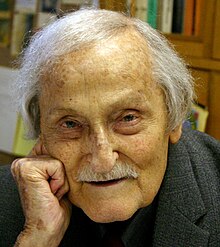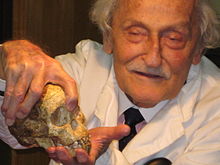Phillip Tobias
Phillip Vallentine Tobias (born October 14, 1925 in Durban ; † June 7, 2012 in Johannesburg ) was a South African paleoanthropologist and author of more than 1100 scientific publications .
In his obituary in the journal Nature, Bernard Wood referred to him as the “ doyen of the paleoanthropological scientific community ” who headed the excavations in Sterkfontein for more than half a century . In Science Tim White wrote : "Africa has now lost one of her greatest scientists."
Career
Phillip Tobias attended St. Andrew's School in Bloemfontein and a secondary school in Durban. From 1942 he studied at the University of the Witwatersrand ( "Wits") in Johannesburg medicine and acquired 1946 its Bachelor Accounts in the subjects of physiology , histology and embryology . He later specialized in anatomy and genetics as part of his master’s degree (graduated in 1950), and he also obtained his first doctorate in genetics in 1953; he later earned a second doctorate in paleoanthropology. As early as the late 1940s, Tobias came into contact with Raymond Dart , who was then head of the anatomy department and shortly before discovered what was called the “ child of Taung ” by a quarry worker near Taung and later called the “ child of Taung ” as the fossil of the previously unknown species of Australopithecus africanus had described.
In the early 1950s, Tobias decided to stay in South Africa despite the tightened apartheid system and to fight against it at his university. As President of the National Union of South African Students , Tobias founded the first anti-apartheid movement at South African universities as early as 1949 . When Steve Biko died in police custody in 1977 , it was Tobias who started a judicial investigation.
From 1959 until his retirement in 1993 he was professor and head of the department of anatomy at the medical faculty of the University of the Witwatersrand.
Research topics
After completing his doctoral thesis, Tobias took part in an expedition aimed at studying the San people in the Kalahari desert . He later referred to this in his autobiography Into the Past: A Memoir. as a key experience that made him a researcher in the field of anthropology.
In 1955/56 he examined hominine fossils that were kept in Great Britain , France and the USA . He then returned to South Africa, taught at the "Wits" and in 1959, shortly after the death of Raymond Dart, was appointed head of the Department of Anatomy at the University of the Witwatersrand. In the same year he was invited by Mary Leakey and Louis Leakey to take part in the processing of the type specimen of the skull find called Zinjanthropus boisei (today: Paranthropus boisei ) . Until the early 1990s, the hominin finds he discovered totaled more than 600 fossils, mostly of Australopithecus africanus .
He was next to Ron Clarke co-author of the first publication of foot bones, leading to a Australopithecus - including fossil, known as " Little Foot was known." He and John Russell Napier also wrote the extremely detailed first description of Homo habilis , the bones of which were recovered by Louis Leakey in 1964 and given to the two researchers for more detailed analysis.
Awards

In 1987 Phillip Tobias received the Balzan Prize and in 1997 the Charles R. Darwin Lifetime Achievement Award from the American Association of Physical Anthropologists . In recognition of his academic and political achievements, he was in 1992 by President de Klerk to the Order of Meritorious Service in gold and in 1999 by President Nelson Mandela with the Order of the Southern Cross of South Africa awarded the silver.
He was a founding member of the Academy of Science of South Africa and a Fellow of the Royal Society .
The Royal Society of South Africa accepted him as one of two South African members and awarded him the rarely awarded John Herschel Medal .
In 1986 he was elected to the American Academy of Arts and Sciences , 1987 to the National Academy of Sciences and 1996 to the American Philosophical Society .
Fonts (selection)
- with Louis Leakey and John Russell Napier : A new species of the genus Homo from Olduvai Gorge. In: Nature . Volume 202, 1964, pp. 7-9, doi: 10.1038 / 202007a0 , full text (PDF; 344 kB) .
- with Gustav Heinrich Ralph von Koenigswald : A Comparison Between the Olduvai Hominines and those of Java and some Implications for Hominid Phylogeny. In: Nature. Volume 204, 1964, pp. 515-518, doi: 10.1038 / 204515a0
- Olduvai Gorge. Volume 2: The Cranium and Maxillary Dentition of Australopithecus (Zinjanthropus) boisei. Cambridge University Press, New York 1967.
- Olduvai Gorge. Volume 4: The skulls, endocasts and teeth of Homo habilis. Cambridge University Press, Cambridge / New York 1991, ISBN 0-521-75886-6 .
- with Ronald J. Clarke : Sterkfontein member 2 foot bones of the oldest South African hominid. In: Science . Volume 269, 1995, pp. 521-524, doi: 10.1126 / science.7624772 .
- Into the Past: A Memoir. Picador Africa, 2005, ISBN 1-7701001-5-6 .
literature
- Bernard Wood : Phillip Vallentine Tobias (1925–2012). In: Nature. Volume 487, No. 7405, 2012, p. 40, doi: 10.1038 / 487040a
- Tim D. White : Phillip V. Tobias (1925-2012). In: Science. Volume 337, No. 6093, 2012, p. 423, doi: 10.1126 / science.1225988
Web links
- Hamba bald Prof. Phillip Tobias. Obituary of the University of the Witwatersrand dated June 7, 2012
- South Africa's beloved Professor Phillip Tobias dies. ( Memento of June 9, 2012 in the Internet Archive ) Obituary of the Gauteng Tourism Authority of June 7, 2012
- Complete reading list
Individual evidence
- ↑ Scientist Phillip Tobias dies. On: news24.com from June 7, 2012
- ↑ Entry on Tobias; Phillip Vallentine (1925-2012); Professor in the Archives of the Royal Society , London
- ↑ List of recipients of the order 1999 sahistory.org.za (English), accessed on August 25, 2018
- ↑ Member History: Phillip V. Tobias. American Philosophical Society, accessed December 7, 2018 (with biographical notes).
| personal data | |
|---|---|
| SURNAME | Tobias, Phillip |
| ALTERNATIVE NAMES | Tobias, Phillip Vallentine (full name) |
| BRIEF DESCRIPTION | South African paleoanthropologist |
| DATE OF BIRTH | October 14, 1925 |
| PLACE OF BIRTH | Durban |
| DATE OF DEATH | June 7, 2012 |
| Place of death | Johannesburg |

